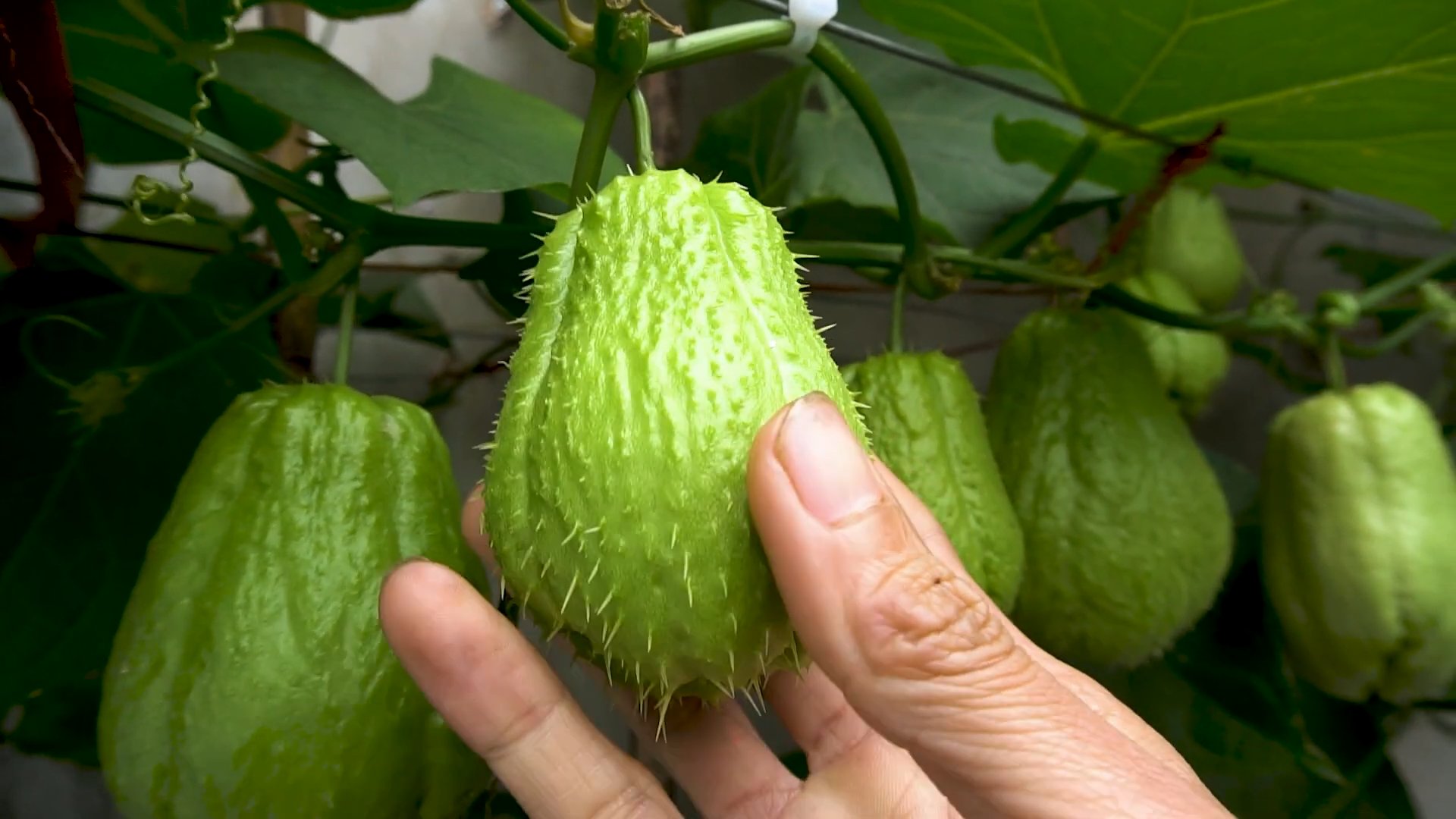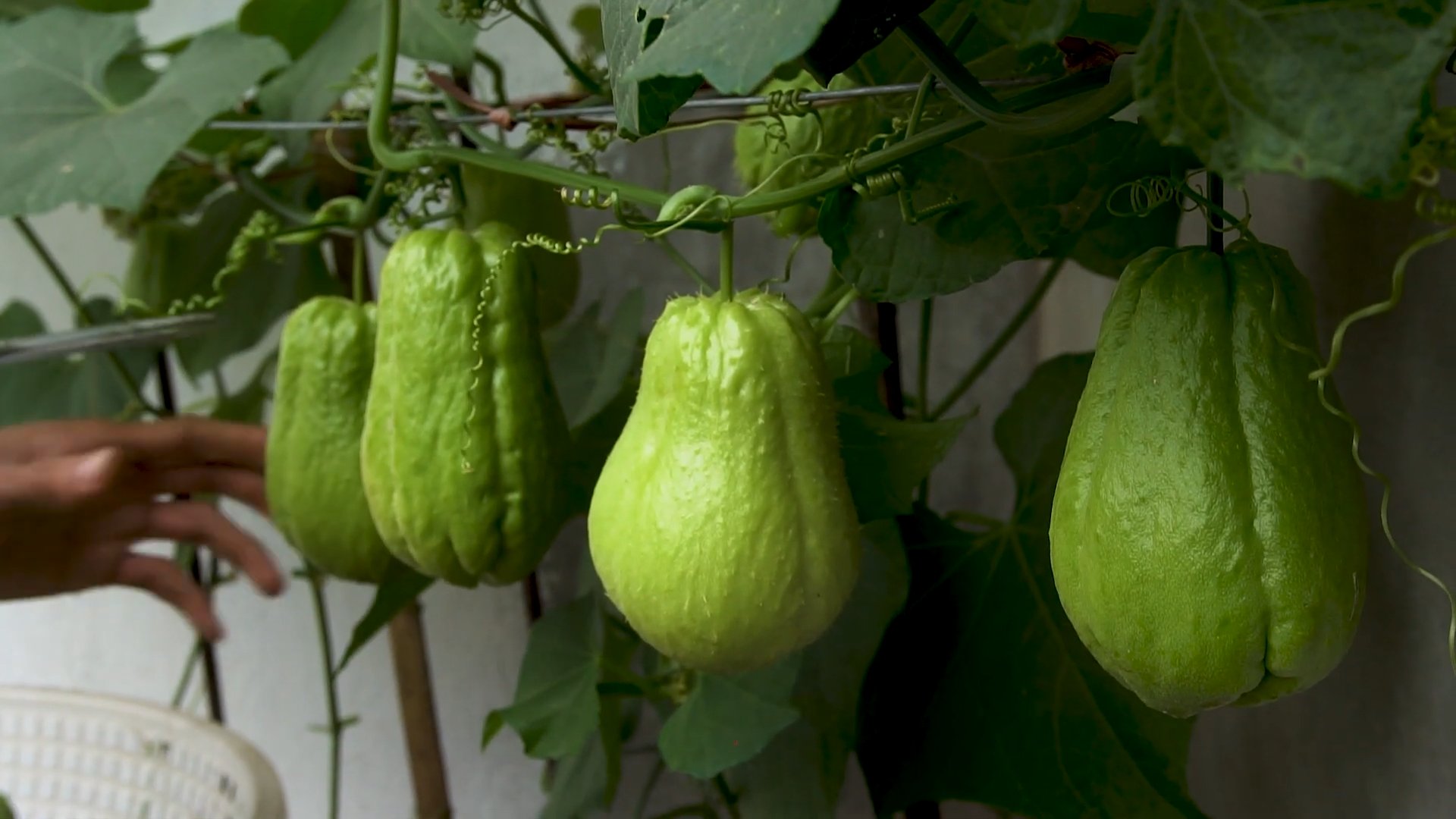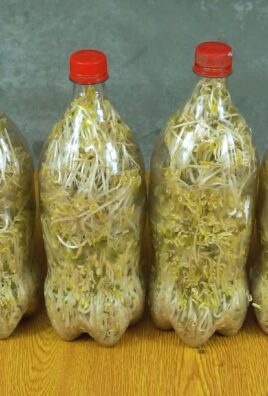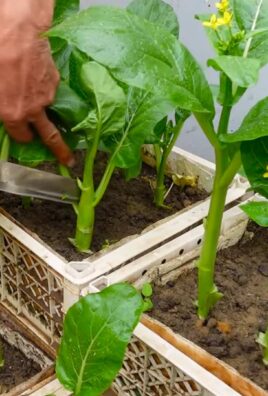Grow Chayote, also known as mirliton or vegetable pear, might just be the most rewarding and surprisingly easy-to-cultivate vine you’ve never heard of! Have you ever dreamt of harvesting an abundance of delicious, versatile fruit right from your own backyard, with minimal effort? This DIY guide will unlock the secrets to successfully growing chayote, even if you’re a complete beginner.
Chayote has a fascinating history, deeply rooted in Mesoamerican cultures. For centuries, it has been a staple food, prized for its nutritional value and adaptability. Imagine, you’re connecting with a tradition that stretches back through generations, all while enjoying fresh, homegrown produce.
Why should you learn this DIY trick? Well, for starters, chayote is incredibly prolific. One plant can yield dozens, even hundreds, of fruits! Plus, in today’s world, where we’re all looking for ways to be more sustainable and reduce our grocery bills, growing your own food is a fantastic solution. This grow chayote beginner’s guide will provide you with all the knowledge you need to get started, from selecting the right chayote fruit for planting to harvesting your bountiful crop. Get ready to impress your friends and family with your green thumb and enjoy the delicious rewards of your labor!

Growing Chayote: A Beginner’s Guide to Bountiful Harvests
So, you’re thinking about growing chayote? Awesome! It’s a fantastic, versatile vegetable (or is it a fruit? We’ll get to that!) that’s surprisingly easy to grow, even if you’re a complete beginner. I’m going to walk you through everything you need to know, from choosing your chayote to harvesting your delicious bounty. Get ready to impress your friends and family with your homegrown goodness!
What is Chayote, Anyway?
Before we dive in, let’s talk about what chayote actually *is*. Technically, it’s a fruit, but it’s generally used as a vegetable in cooking. It’s a member of the squash family, along with pumpkins, zucchini, and cucumbers. It has a mild, slightly sweet flavor that’s often compared to zucchini or cucumber. You can eat the fruit, the leaves, the shoots, and even the root! It’s a nutritional powerhouse, packed with vitamins, minerals, and fiber. Plus, it’s incredibly versatile in the kitchen – you can boil it, bake it, fry it, stuff it, or even eat it raw in salads.
Choosing Your Chayote: The Seed is the Fruit!
Here’s the cool part about chayote: you don’t start with seeds. You start with the whole fruit! The seed is *inside* the fruit and will germinate while still inside.
* Finding a Healthy Fruit: Look for a mature chayote fruit at your local grocery store or farmers market. Choose one that’s firm, unblemished, and has a few sprouts already emerging from the bottom (the blossom end). This is a good sign that it’s ready to grow. If you can’t find one with sprouts, don’t worry! You can still get it to sprout yourself.
* Variety Matters (Sort Of): There are different varieties of chayote, but honestly, unless you’re a serious chayote enthusiast, the specific variety doesn’t matter too much. The most common type is pear-shaped and light green.
* Organic is Best: If possible, choose an organic chayote to avoid any potential pesticide residue.
Sprouting Your Chayote: Getting Ready to Grow
If your chayote doesn’t already have sprouts, you’ll need to encourage it to sprout before planting. This is a simple process, but it’s crucial for success.
1. Wrap it Up: Wrap the chayote fruit in a damp paper towel.
2. Bag it: Place the wrapped fruit in a plastic bag or container. This will help retain moisture.
3. Warm and Dark: Store the bag in a warm, dark place, like a cupboard or pantry.
4. Check Regularly: Check the fruit every few days to make sure the paper towel is still damp. If it’s drying out, re-moisten it.
5. Patience is Key: It can take anywhere from a few days to a few weeks for the chayote to sprout. Be patient! You’ll see a small vine emerging from the blossom end.
Preparing Your Garden: Location, Location, Location!
Chayote vines are vigorous growers, so they need plenty of space and a strong support structure.
* Sunlight: Chayote needs at least 6-8 hours of sunlight per day. Choose a location in your garden that gets plenty of sun.
* Soil: Chayote prefers well-drained soil that’s rich in organic matter. Amend your soil with compost or aged manure before planting.
* Support Structure: This is crucial! Chayote vines can grow up to 30-40 feet long, so they need a sturdy trellis, fence, or arbor to climb on. Make sure your support structure is strong enough to handle the weight of the mature vine and its fruits. I’ve seen people use everything from chain-link fences to homemade wooden trellises. Get creative!
* Spacing: If you’re planting multiple chayote plants, space them at least 10-15 feet apart. They need plenty of room to spread out.
Planting Your Chayote: Getting it in the Ground
Once your chayote has sprouted and your garden is prepared, it’s time to plant!
1. Dig a Hole: Dig a hole that’s slightly larger than the chayote fruit.
2. Position the Fruit: Place the chayote fruit in the hole with the sprouted end pointing upwards.
3. Cover Partially: Cover the fruit with soil, leaving the sprouted end exposed. You don’t want to bury the entire fruit.
4. Water Well: Water the newly planted chayote thoroughly.
5. Mulch: Add a layer of mulch around the base of the plant to help retain moisture and suppress weeds.
Caring for Your Chayote: Watering, Fertilizing, and Pruning
Chayote is relatively low-maintenance, but it does need some care to thrive.
* Watering: Water your chayote plant regularly, especially during dry periods. Aim for consistent moisture, but avoid overwatering, which can lead to root rot.
* Fertilizing: Fertilize your chayote plant every few weeks with a balanced fertilizer. You can also add compost or aged manure to the soil around the plant.
* Pruning: Pruning isn’t strictly necessary, but it can help to control the size of the vine and improve air circulation. You can prune back any excessive growth or remove any dead or damaged leaves.
* Pest Control: Chayote is generally pest-resistant, but it can be susceptible to aphids, squash bugs, and vine borers. Inspect your plant regularly for pests and take action if you see any. You can use insecticidal soap or neem oil to control pests.
* Training the Vine: As the vine grows, you’ll need to train it to climb your support structure. Gently guide the vine and tie it to the trellis or fence as needed.
Harvesting Your Chayote: Enjoying the Fruits (and Shoots and Leaves!) of Your Labor
Harvest time is the most rewarding part of growing chayote!
* When to Harvest the Fruit: You can harvest chayote fruits when they’re about 4-6 inches long and still tender. The skin should be smooth and light green. You can harvest them at a larger size, but they may be tougher and less flavorful.
* How to Harvest the Fruit: Use a sharp knife or pruners to cut the fruit from the vine.
* Harvesting the Shoots and Leaves: You can also harvest the young shoots and leaves of the chayote plant. They’re delicious in salads or stir-fries. Harvest them when they’re young and tender.
* Storage: Chayote fruits can be stored in the refrigerator for several weeks.
Using Your Chayote: Culinary Adventures Await!
Now that you’ve harvested your chayote, it’s time to get cooking! Here are just a few ideas:
* Sautéed Chayote: Slice the chayote and sauté it with garlic, onions, and your favorite herbs.
* Stuffed Chayote: Hollow out the chayote and stuff it with ground meat, rice, and vegetables. Bake until tender.
* Chayote Salad: Grate raw chayote and toss it with a vinaigrette dressing.
* Chayote Soup: Add diced chayote to your favorite soup recipe.
* Pickled Chayote: Pickle chayote for a tangy and refreshing treat.
* Chayote Fritters: Grate chayote, mix it with flour, eggs, and spices, and fry into fritters.
Troubleshooting: Common Chayote Problems and Solutions
Even with the best care, you might encounter some problems while growing chayote. Here are a few common issues and how to address them:
* No Fruit Production: This is a common problem with chayote. It can be caused by a lack of pollination, insufficient sunlight, or poor soil. Make sure your plant is getting enough sunlight and that the soil is well-drained and rich in organic matter. You can also try hand-pollinating the flowers.
* Yellowing Leaves: Yellowing leaves can be a sign of overwatering, nutrient deficiency, or pest infestation. Check the soil moisture and adjust your watering schedule accordingly. Fertilize your plant with a balanced fertilizer. Inspect the leaves for pests and take action if you see any.
* Root Rot: Root rot is caused by overwatering and poor drainage. Make sure your soil is well-drained and avoid overwatering. If you suspect root rot, you can try transplanting the plant to a new location with better drainage.
* Pest Infestation: As mentioned earlier, chayote can be susceptible to aphids, squash bugs, and vine borers. Inspect your plant regularly for pests

Conclusion
So, there you have it! Growing chayote, even for beginners, is entirely achievable and incredibly rewarding. This isn’t just about adding another vegetable to your garden; it’s about embracing a sustainable practice, enjoying fresh, homegrown produce, and potentially sharing the bounty with your community. The ease of propagation, the vigorous growth habit, and the versatility of the fruit make chayote a truly exceptional addition to any garden, regardless of size.
We’ve covered everything from selecting the right chayote fruit for planting to providing the necessary support for its sprawling vines. Remember, patience is key, especially in the initial stages. Don’t be discouraged if you don’t see immediate results. Chayote can be a bit slow to start, but once it takes off, you’ll be amazed by its productivity.
This DIY guide to growing chayote is a must-try for several reasons. First, you’ll have access to incredibly fresh and flavorful chayote, far superior to anything you can find in most grocery stores. Second, you’ll be contributing to a more sustainable food system by reducing your reliance on commercially grown produce. Third, you’ll gain a sense of accomplishment and connection to nature that comes from nurturing your own food. Finally, you’ll have the opportunity to experiment with different chayote varieties and culinary applications.
Consider these variations to personalize your chayote growing experience:
* **Vertical Gardening:** If you’re short on space, train your chayote vine to grow vertically on a trellis or fence. This not only saves space but also creates a beautiful green wall.
* **Container Gardening:** While chayote thrives best in the ground, you can successfully grow it in a large container (at least 20 gallons) with proper drainage and support.
* **Different Varieties:** Explore different chayote varieties, such as the green-skinned, pear-shaped variety or the white-skinned, spikier variety. Each variety has a slightly different flavor and texture.
* **Companion Planting:** Plant companion plants like marigolds, basil, or nasturtiums near your chayote to deter pests and attract beneficial insects.
We wholeheartedly encourage you to embark on this chayote growing adventure. It’s a fun, educational, and ultimately delicious experience. Don’t be afraid to experiment, learn from your mistakes, and adapt the techniques to suit your specific climate and growing conditions.
Once you’ve harvested your first chayote, be sure to explore the many culinary possibilities. From stir-fries and soups to salads and pickles, chayote is a versatile ingredient that can be used in a wide range of dishes. And don’t forget the leaves and shoots, which are also edible and nutritious!
We’re confident that you’ll find growing chayote to be a rewarding and enjoyable experience. So, grab a chayote fruit, follow our guide, and get ready to enjoy the fruits (and vegetables!) of your labor.
We’d love to hear about your experiences growing chayote! Share your tips, tricks, and photos in the comments below. Let’s create a community of chayote enthusiasts and learn from each other. Happy gardening!
Frequently Asked Questions (FAQ)
What is the best time of year to plant chayote?
The ideal time to plant chayote is in the spring, after the last frost. This gives the plant ample time to establish itself and produce fruit before the onset of colder weather. In warmer climates with mild winters, you may be able to plant chayote in the fall. However, in colder climates, it’s best to start the chayote indoors a few weeks before the last frost to give it a head start. This involves placing the whole fruit in a warm, humid environment until it sprouts, then transplanting it outdoors once the weather is suitable.
How much sunlight does chayote need?
Chayote requires at least 6-8 hours of direct sunlight per day to thrive. Choose a planting location that receives plenty of sunlight throughout the day. If you’re growing chayote in a container, make sure to place it in a sunny spot. Insufficient sunlight can lead to poor growth and reduced fruit production.
What type of soil is best for growing chayote?
Chayote prefers well-drained soil that is rich in organic matter. Amend your soil with compost or other organic materials before planting to improve its fertility and drainage. A slightly acidic to neutral soil pH (6.0-7.0) is ideal. Avoid planting chayote in heavy clay soil, as this can lead to root rot. If you have clay soil, consider growing chayote in a raised bed or container with a well-draining potting mix.
How often should I water chayote?
Water chayote regularly, especially during hot, dry weather. Keep the soil consistently moist, but avoid overwatering, which can lead to root rot. Water deeply and less frequently, rather than shallowly and more often. Check the soil moisture regularly and water when the top inch of soil feels dry to the touch. During periods of heavy rainfall, you may need to reduce watering.
What kind of support does chayote need?
Chayote is a vigorous vine that requires strong support to climb. Provide a sturdy trellis, fence, or arbor for the vine to grow on. The support should be at least 6-8 feet tall and wide enough to accommodate the vine’s sprawling growth habit. Regularly prune the vine to keep it manageable and prevent it from becoming too heavy for the support structure.
How long does it take for chayote to produce fruit?
Chayote typically takes 4-6 months to produce fruit after planting. The exact time will depend on the variety, climate, and growing conditions. Be patient and continue to provide proper care, and you’ll eventually be rewarded with a bountiful harvest.
How do I know when chayote is ripe?
Chayote is typically harvested when it is still young and tender, about 4-6 inches in length. The skin should be smooth and unblemished. Avoid harvesting chayote that is overly mature, as it can become tough and fibrous. You can gently press on the fruit to check for ripeness. It should feel firm but slightly yielding.
Are there any pests or diseases that affect chayote?
Chayote is generally resistant to pests and diseases, but it can be susceptible to aphids, spider mites, and squash bugs. Regularly inspect your plants for signs of infestation and take appropriate action if necessary. You can use insecticidal soap or neem oil to control pests. Root rot can also be a problem in poorly drained soil. Ensure that your soil is well-draining and avoid overwatering.
Can I eat the entire chayote plant?
Yes, most parts of the chayote plant are edible, including the fruit, leaves, shoots, and roots. The fruit is the most commonly consumed part, but the leaves and shoots can also be used in salads, stir-fries, and soups. The roots are starchy and can be cooked like potatoes.
How do I store chayote?
Store chayote in the refrigerator for up to 2-3 weeks. Wrap the fruit in a plastic bag to prevent it from drying out. You can also freeze chayote for longer storage. Blanch the fruit for 2-3 minutes before freezing to preserve its quality.





Leave a Comment